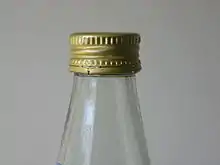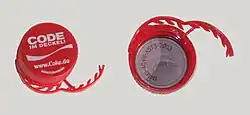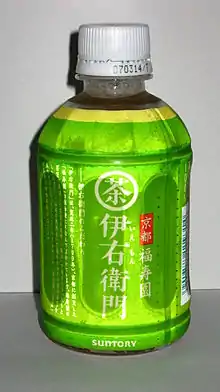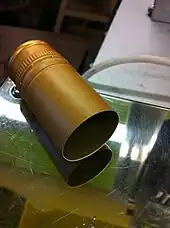Tamper-evident band
A tamper-evident band or security ring serves as a tamper resistant or tamper evident function to a screw cap, lid, or closure.[1] The term tamper-proof is sometimes used but is considered a misnomer given that pilfering is still technically possible.[2]




A security band can be integrated with the cap or can be a separate package component. It is a plastic or metal structure around the circumference (usually) of the closure that is often found attached below a closure in bottles, jars, and tubs.
Several variations have been developed for caps, lids, and closures.[3] [4][5][6] The use of custom printing and security printing is available. Perforations or other areas of weakness are often used to initiate and control a tear. Sometimes engineered frangibility is used for break-away functions.
While tamper-evident bands are not considered a challenge for recycling, it is important that the band stays attached to the cap in case of refillable bottles, because it is hard to remove the rings from intact bottles in an economical way.[1]
The opening ring is a tamper warning: if the seal between the ring and the cap is broken, it is an indication that the cap has been opened.[1][7]
Purposes
Security opening rings might have several possible purposes:
- Provide clear evidence of container being opened
- Deter tampering
- Deter package pilferage
- Deter product adulteration
- Improved closure strength during shipping
- Regulatory requirement (sometimes)
Roll-on metal closures
When an aluminum or plastic bottle cap has an integral band, it is usually connected by thin bridges. They can be molded along with the cap or slit afterwards.[1] When unscrewing the cap, the frangible ring breaks: the ring can separate from the cap, and two separate pieces remain, the sealing piece and the leftover ring; or the broken ring can form a "pigtail" still attached to the cap.
Shrink bands
Separate bands of shrink film can be placed over the closure and tightened in a shrink tunnel.[8] Some have perforations or nicks to help initiate the tear.
Other
Most standard pressure sensitive tapes do not have a high degree of tamper evidence. Some special security tapes have additional tamper evident features which offer better tamper evidence. Some have intentional weakness which cause breakage or delamination; others have hidden messages which appear upon opening.
Examples
 plastic screw cap with break-away band
plastic screw cap with break-away band plastic screw cap with break-away band
plastic screw cap with break-away band Cross strip of PSA security tape with frangible backing
Cross strip of PSA security tape with frangible backing A capsule is fitted onto a wine bottle and heat shrunk tightly
A capsule is fitted onto a wine bottle and heat shrunk tightly in-line heating of shrink bands on plastic bottles of water
in-line heating of shrink bands on plastic bottles of water
See also
References
- Ottmar Brandau (2012). Bottles, Preforms and Closures: A Design Guide for PET Packaging. William Andrew. pp. 134–. ISBN 978-1-4377-3526-0.
- H. Lockhart; Frank Albert Paine (1996). Packaging of Pharmaceuticals and Healthcare Products. Springer. pp. 125–. ISBN 978-0-7514-0167-7.
- US 3904062, Grussen, Jean, "Tamper-proof and loss-proof screw-type bottle cap", published 1975-09-09, assigned to Somepla SA
- US 5913437, Ma, Xiaoli, "Tamper evident bottle cap", published 1999-06-22, assigned to Portola Packaging Inc.
- US 6550626, Randall, Jeffrey T., "Closure lid and resealable closure system with tamper-evident features", published 2003-04-22, assigned to Seaquist Closures Foreign Inc.
- US 4732293, Landis, H. Richard, "Tear strip closure for a container with a security ring", published 1988-03-22, assigned to Landis Plastics Inc.
- A.J. Mitchell (1990). Formulation and Production Carbonated Soft Drinks. Springer. pp. 170–. ISBN 978-0-442-30287-0.
- US 5390477, Sowden, Harry, "System for applying a heat shrinkable sleeve to a container", published 1995-02-21, assigned to McNeilab Inc.
Further reading
- Yam, K. L., "Encyclopedia of Packaging Technology", John Wiley & Sons, 2009, ISBN 978-0-470-08704-6
- "Improving Tamper-Evident Packaging: Problems, Tests and Solutions", Jack L. Rosette, 1992